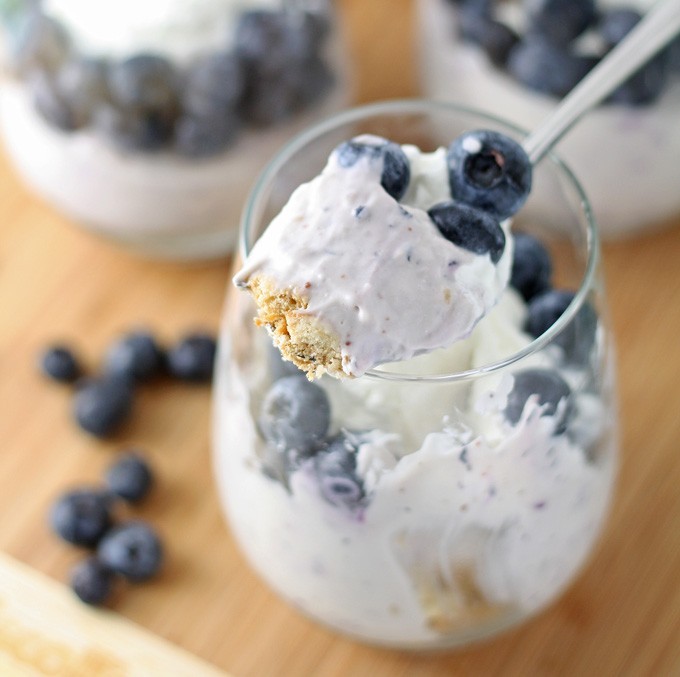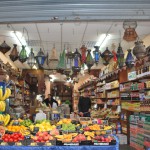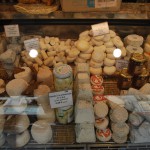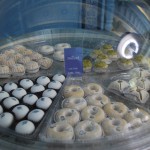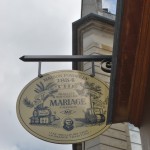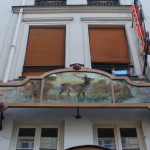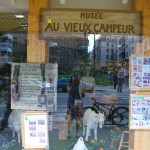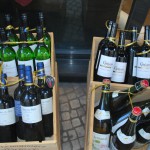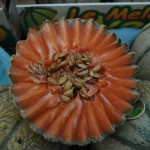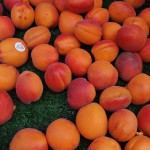by Alice DeLuca
Musing over 16th century drawings of highly specialized, obsolete cooking equipment from Il Cuoco segreto di Papa Pio V (The Private Chef of Pope Pius V)[i], I was prompted to remember the seasonal holiday, now over a decade old, that causes lots of fun-loving souls to pretend to be pirates. “Talk Like a Pirate Day” is a silly parade of all things pirate, associated with the violent pirates of the great age of sail, not the modern-day pirates in business suits. This holiday is now upon us, September 19, so we can give a little thought to what a pirate might eat.
By an amazing coincidence, whilst rummaging through a musty old trunk in a spider-filled corner of the attic today, I came upon a weathered scrap of paper wrapped up in a bit of tarred leather. The picture drawn thereon is unlike the idealized food plate recently released by the U.S. government[ii], but illustrates the proper proportions of pirate foods as depicted in fiction and history books – a surefire recipe for scurvy and pellagra, ancient diseases now rarely encountered:
Pirate Plate:

United States Department of Agriculture Plate:

If you haven’t recently read Treasure Island, written by Robert Louis Stevenson in the late 19th century about 18th century pirates, take it in your hands again – it is a wild adventure story, available as an ebook through Project Gutenberg, at no cost. There is some value to the book as a culinary guide, since Stevenson traveled at sea quite a bit, voyaging to Hawaii numerous times, becoming friends with Hawaiian King Kalākaua (the Merrie Monarch) and meeting his demise in Samoa. He was onboard ship only a hundred years after the period of his pirate story that holds our attention.
The first ten percent of Treasure Island is a riveting description of the family of innkeepers managing the Admiral Benbow tavern, as they are terrorized by a raging alcoholic in his last days. The buccaneer lodger’s drunken ravings and addiction to rum are a part of nearly every page. Pirates from the age of sail would have drunk beer, because that ancient drink is preserved by hops and therefore is safer than standing water, and they would have drunk great quantities of rum.
Pirates certainly appeared to “eat to live” instead of “living to eat” like a modern gourmet. Combing through the material in Treasure Island, I can provide a nearly comprehensive list of the drinks and foods mentioned in that tome, but I follow up with a proposal for a more appetizing menu:
Pirate Food enumerated in Treasure Island
A bottle of Spanish wine and some raisins, strong wine (red or white), old wine, a pannikin of rum, casks of whiskey, brandy.
Duff, plum-duff, bags of biscuits, bread-bags, biscuit and fried junk.
Goat or salted goat, kegs of pork, roasted oxen, hot bacon or bacon and eggs, oysters.
Pork, bread and brandy for the midday meal.
Apples, berries, tropical fruits, pickled fruits.
Nutmeg.
Notably, when the marooned Ben Gunn dreams of food, he dreams of
“Cheese toasted”, and would have preferred a piece of parmesan cheese and some Port to any dish of boiled, salted meat and “duff.”
Here is a much improved Luncheon menu for your consideration, loosely based on Treasure Island:

Grog – The proper Treasure Island toast to make would be “Here’s luck” – as you down your diluted drink of rum and water. If we are to believe everything we read, rum was added to the stored, algae-contaminated water onboard ship, to make it more palatable. However, we also know that the British Royal Navy made rum a staple, and served the last official ration of rum to its sailors July 31, 1970 after a few centuries of providing daily rum rations. For a palatable drink that would ward of scurvy and please your guests, serve a Mojito made with rum, mint and limes, or a Caipirinha made from Brazilian Cachaça.
Main course – Barbecue, shared equally amongst all diners. The alleged origin of the word “buccaneer” is the French word boucanier that comes from the word boucan that referred to a wooden frame used in the Caribbean for smoking meat. This certainly seems like a plausible history, whether or not it is true. The character Long John Silver’s nickname in Treasure Island is “Barbecue,” as he is the ship’s cook.
A Ben Gunn Toasted Cheese Sandwich: In honor of all who are marooned, whether at sea on a deserted island or in a modern city apartment, serve a toasted cheese sandwich made with fine cheese.
Salamagundi: Salamagundi was somewhat similar to the modern-day Salade Niçoise or Cobb Salad. Richard Wilk[iii] gives a recipe that includes romaine lettuce, cooked meat and poultry, anchovies or other small fish such as herring, hard-boiled eggs, pickled vegetables, onions, watercress, palm hearts and parsley or cilantro, nicely arranged and served up with a familiar vinaigrette made with hot mustard.
Pickled Fruits:

plums and apricots make nice pickled fruits
According to Richard Wilk[iv], the pirates who worked in Central America had access to pickled foods. Perhaps the modern pirate, a hedge-fund trader betting against the success of some hopeful entrepreneurial company, would prefer some other pickle, but an old-time pirate would have had access to pickled fruits:
Modern Recipe for Pickled Fruits, (made using the convenient refrigerator):
These pickled fruits are delicious, and if you prepare them now and refrigerate them instead of “canning” them, they will be ready for your Thanksgiving table without a great deal of fuss. The Italian Prune Plum, only available for about 3 weeks each September, is the right fruit to use, so make the pickles now. For each pound of firm but ripe “Italian prune plums” or apricots (shown in the picture above), allow the following:
1 ½ inches of cinnamon stick
2-3 whole cloves
1 cup sugar
1 cup vinegar
These measurements are for one pound of fruit. Leave the fruit whole. Wash all the fruit and prick the skin of each whole fruit in three places with a wooden toothpick. Put the fruits and spices in a large bowl that is safe to use with vinegar – stainless steel, glass or modern food-safe ceramic. Boil the vinegar and sugar to make a syrup, cooking until the sugar dissolves. Pour the hot syrup over the fruit and spices and let sit until completely cool. Then cover to keep out fruit flies and allow to sit for 2 days. A thin white scum may rise to the surface; just scoop it off.
Drain the plums, reserving the syrup. Bring the syrup to a boil and pour it back over the plums. Let the plums cool again, cover and let sit for 1 day covered (room temperature.)
On the 4th day, bring the whole mixture (plums and syrup) to a boil in a heavy pot, then reduce the heat and simmer for 10 minutes. Do not overcook the fruit. Drain the fruit again, reserving the syrup. Using a large spoon, pack the fruit in to a sterilized quart jar, then boil the syrup until reduced to 1 cup. Pour the boiling syrup carefully over the fruit, then seal immediately (there may be leftover syrup) and let stand in the refrigerator for 2 weeks before serving.
Plum Duff – don’t bother with Plum Duff, read on, and you will see why:
Recipes for plum duff (dough) call for kneading flour, suet, salt, water and raisins or currants in to a ball, placing the ball of dough in to a pudding bag and suspending the bag in boiling water for a period of hours, turning the bag from time to time so that the material in the bag does not burn from extended contact with the edge of the pot. This apparently makes a sort of dumpling-like creation that can be sliced and eaten with boiled salt pork or beef. As my own diet does not include flour, I am spared from recreating this nasty recipe for a staple of antiquity.[v]
Instead of plum duff, you could create Pieces of Eight – I am imagining a shortbread 8-reale coin-shaped cookie that can be broken in to eight “bits”. I think that any shortbread recipe would be suitable for this project. Just score the cookie into 8 wedges with a knife before baking as you might a giant shortbread. Sounds like fun, and I just may try it!
It might be fun, if one owned an Inn or a Bed-and-Breakfast, to offer a “Talk Like a Pirate Day” meal. But take great care to recall the difficulties of the family managing the Admiral Benbow, an Inn overrun by drunken buccaneers tipping each other the black spot, helping themselves to rum from the bar, stroking-out in the main dining room and convalescing in bed. You never know who may rent a room.
[i] Gillies, Linda, Anita Muller, and Pamela Patterson. A culinary collection; recipes from members of the Board of Trustees and staff of the Metropolitan Museum of Art.. New York: Metropolitan Museum of Art, 1973. Print.
[ii] http://www.choosemyplate.gov/images/MyPlateImages/MyPlate-green300x273.jpg
[iii] Wilk, Richard R. Home cooking in the global village: Caribbean food from buccaneers to ecotourists. English ed. Oxford ; New York: Berg, 2006. Print. P.49
[v] http://www.britishfoodinamerica.com/Our-First-Nautical-Number/the-lyrical/Food-at-sea-in-the-age-of-fighting-sail/
